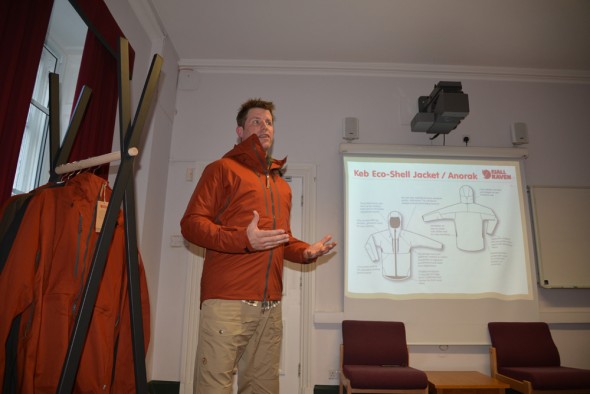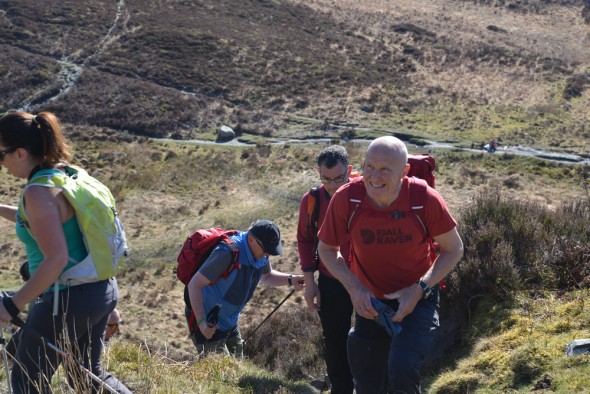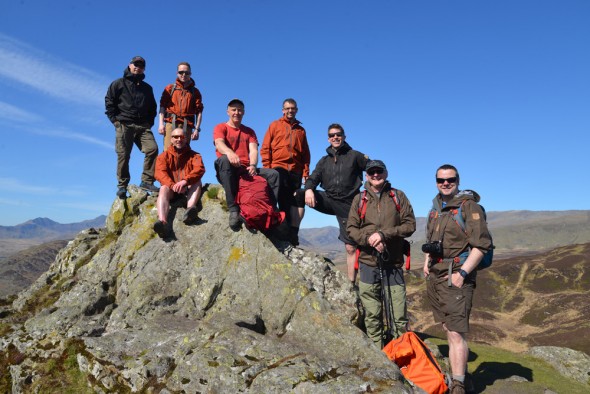
Discussing the finer details of Eco-Shell
This April, Trek & Mountain was invited to The National Mountain Centre at Plas y Brenin for a sneak preview and testing session of a major new product from Swedish brand Fjällräven, called Eco-Shell (pronounced ‘echo-shell’, not ‘ee-co shell’). For the event, Fjällräven had drafted in 8,000m man and newly-appointed brand ambassador Alan Hinkes, who would lead our select group of outdoor journalists on a walk in the hills on the second day of the event.
So why the big deal? Well, Eco-shell is the first ever waterproof/breathable membrane from Fjällräven, their traditional G1000 waxed cotton/polyester material having been their mainstay fabric for many years. Being Fjällräven, Eco-Shell is a waterproof/breathable membrane with a difference – and the biggest difference in this instance is its green credentials. Firstly, the face fabric is made of recycled polyester and the garment is itself recyclable. Secondly, its DWR coating doesn’t use the harmful fluoro-carbons that are used in most commonly-used DWRs and, lastly, each garment is climate-compensated to make up for energy expended during manufacture and transportation. That all adds up to a pretty eco-friendly product as far as we can see, yet Eco-Shell’s green credentials don’t come at the cost of performance either, with both the waterproofness and breathability of the fabric on a par with the best membranes currently on the market.

Fjallraven ambassador Alan Hinkes
Initially Eco-Shell will be available on Fjällräven’s more technical product ranges, before being rolled out to more ‘lifestyle’ garments, and we were given a chance to try the Keb Eco-Shell Jacket and Keb Eco-Shell Anorak, both available from this autumn. Keb products get their name from Sweden’s highest peak, Kebnekaise (2,097m), and the new jacket and anorak are suitably technical; napoleon-style chest pockets, YKK waterproof zips and adjustable cuffs and hem are standard, as is a hood that Fjällräven refuse to call ‘helmet-compatible’, yet seems to have enough volume to accommodate one nevertheless. In fact, Alan Hinkes was quick to point out that he’d used the jacket for mountaineering and that it had worked perfectly well with a helmet.
Perhaps Fjällräven are wary of their Keb Eco-Shell Jacket/Anorak being seen as just another top-end technical shell; they shouldn’t be too worried though, as they stand out from the crowd in several ways. For a start the fit is slightly more generous that the normal waist-hugging technical shell – the cut is longer and more relaxed. The colour choices are also far more subdued – or should that be ‘tasteful’ – earthy browns and burnt umbers rather than the typical high-vis lime greens and oranges. And lastly there’s those little touches that make Fjällräven products seem as at home in a nice restaurant as they are a mountainside, typified by the leather zip pull and mountain fox badge of the Keb Eco-Shell garments. This could turn out to be a key factor in gaining sales over rivals.

North Wales at its finest!
Although we didn’t get a chance to test Eco-Shell in anger – the uncharacteristically dry and sunny weather in Snowdonia put paid to that – we approved of the soft feel of the fabric and carefully-thought out features of the Keb Eco-Shell Jacket and Anorak. We’ll be testing it out in more demanding conditions over the coming months, so look out for our full review in a few issues time!
RELATED LINKS
www.fjallraven.com

